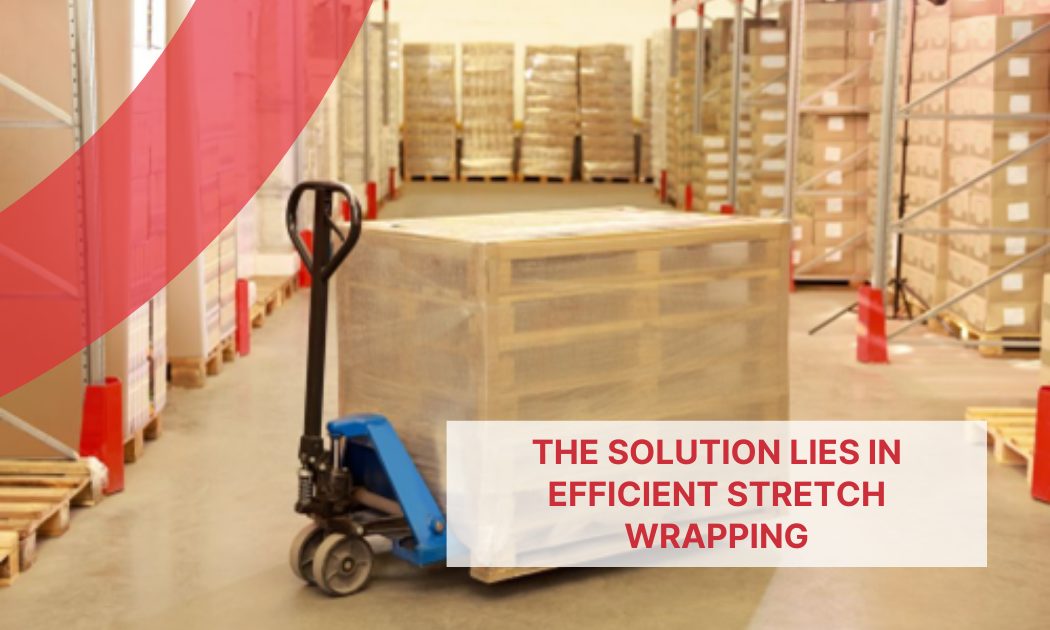Efficient stretch wrapping is your main ally in preventing your products from arriving damaged and causing additional costs for the company. In this article, we explain how to achieve optimal results.
Why Do Products Arrive Damaged at Their Destination?
Products can arrive damaged at their final destination for various reasons, either during the supply chain or in the final packaging process. However, some of these issues are due to improper stretch wrapping. Let’s take a look at some common cases:
- Dust: Dust and other particles can damage or contaminate the goods. This is why, if transported on pallets, it’s advisable to keep them well protected and covered. Additionally, it will prevent contact with liquids. It’s important to remember that some reactions can be harmful and even dangerous in certain cases.
- Humidity: Humidity can damage goods and is often related to environmental factors—but also to poor wrapping. If you want your products to arrive in better condition, we recommend ensuring proper wrapping. Sometimes moisture can seep in, and if a box breaks, the film can help reduce the negative consequences.
- Breakages: These may be caused by incorrect box distribution on the pallet, insufficient film tension, or an improper pallet size. Although other factors may be beyond your control—like transport accidents—the issues above are recurring problems.
The main risk of these situations is that goods may be rejected during clearance checks. That’s why it’s essential to ensure efficient and high-quality stretch wrapping.
How to Guarantee Efficient Stretch Wrapping
Efficient wrapping is the solution to issues related to damaged products. It serves as a protective layer, but also improves space usage by optimizing distribution and load handling. Here are the keys to proper stretch wrapping:
1. Use an Automatic Stretch Wrapper
Using an automatic stretch wrapper is ideal for several reasons. First, it increases wrapping speed, saving time. Second, it provides better precision and quality. And finally, it significantly reduces the risk of workplace accidents. Consequently, it’s the best method for handling a constant wrapping volume.
Manual wrapping always yields lower-quality results than automatic. You can’t achieve the same level of precision without a machine. That’s why this is a crucial step in improving wrapping quality.
2. Choose a Tailored Wrapper (or Strapping Machine)
A tailored stretch wrapper or strapping machine is another essential factor for ensuring quality. There are wrappers for industries like construction, agriculture, food, beverage, or paper, to name a few. Since loads often have irregular dimensions, it’s better to invest in equipment tailored to that reality. Semi-automatic strapping machines are a good choice for less homogeneous loads or occasional use.
In any case, packaging automation must always be adapted to the type of load. While some machines are more versatile, it’s best to tailor the solution. For this, it’s a good idea to consult a specialized manufacturer.
3. Rely on Qualified Professionals
Although less manual labor is needed, it must be qualified. These machines are connected to software that needs to be configured and understood for proper use. Staff training is usually not a big issue, but it’s essential. In some cases, prior knowledge is required; in others, quick training is sufficient.
4. Use High-Quality Film
High-quality film is another essential element. Why? Because it must be correctly tensioned. For instance, to stretch film at a 4:1 ratio, you must ensure the material is appropriate. High-density film typically performs better for this purpose. You must also ensure it fits the machine properly.
To avoid problems, we recommend purchasing high-quality film from a trusted supplier. This minimizes problems and returns. Often, cheap film can turn out costly, as it breaks easily and affects the final wrapping quality.
5. Perform Additional Checks
After wrapping, each shipment must be visually inspected. This ensures everything is in order, with no breakages or misapplied film. The goal is to anticipate issues that may arise during transport. Sometimes, it’s better to rewrap the pallet than deal with a return at the destination. Additionally, if a batch is poorly wrapped, the cause must be identified and resolved.
These tasks are usually carried out as a routine after each wrapping series. Still, if issues arise, they must be addressed immediately to prevent recurrence.
6. Choose the Right Wrapping Technique
Proper wrapping techniques may vary depending on the load type and volume. In some cases, spiral wrapping works well, while for irregular pallets, X-wrapping is more suitable. The goal is not to use more or less film but to ensure wrapping quality.
Each wrapping type has specific features, advantages, and drawbacks. The idea is to get the most precise result, regardless of the amount of film used.
In Summary…
Efficient wrapping requires specialized machinery and technical knowledge. At Movitec, we offer a wide range of automatic stretch wrappers and professional strapping machines with variable speeds per hour. Contact us with no obligation, and we’ll inform you of all the available options!


